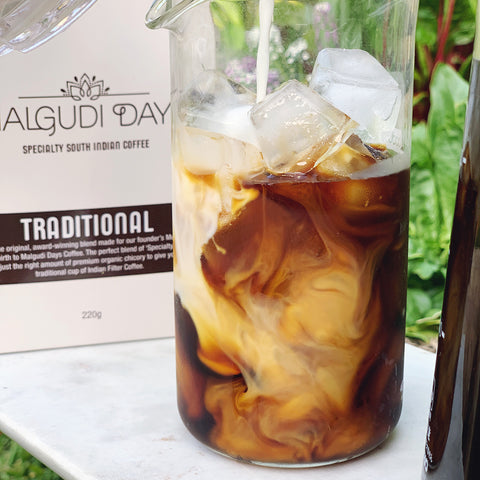Through continued scientific efforts, brewing kaapi at home is no longer a novel experience - it’s as commonplace as cooking rice.
But do you know what the scientific processes are that produce beautiful jars of kaapi decoction?
Knowing the science behind coffee brewing helps you become more mindful while you make coffee at home and generally, it’s just good knowledge to have as a coffee aficionado, isn’t it?
Percolation vs. Immersion
Most coffee makers out there use one of two processes to brew coffee - percolation or immersion.
In immersion, as you can imagine, coffee grounds are steeped in hot water. It is the heat in the vessel that reacts on the grounds and extracts organic flavour compounds into the water to create the decoction.
Cold brew and French press are two methods that use the immersion technique.
In percolation, hot water is run through the coffee grounds. When the bed of coffee grounds come in contact with water, flavour is extracted, and the resulting brew is usually collected in a pot or a different chamber.
The traditional Indian filter coffee maker, stovetop Moka pot, espresso machines, and pour over method apply the principles of percolation.

With immersion, it’s more of a hassle-free method. It usually doesn’t require your constant presence. But there’s also a flip side to it. These coffees can be more heavy-bodied and extract oils and other compounds too, which may not always be a good thing.
When you decide to use brew gear that percolates coffee, the grounds come into contact with water for a brief moment only. So, you get a more clean and crisp flavour profile.
Factors That Influence Flavour
Even if two people bought the exact same coffee from the same plot, roasted & sold by the same roaster, and used the same brewing method, there are chances that their coffee would taste differently.
The reason for this is that factors such as quantity of coffee & water, water temperature, grind size, and brewing time affect the flavour profile of the brew.
Let’s understand how each of these work:
-
Grind Size: Coffee grounds can vary in terms of how well ground they are. The finer the ground, the faster and more accurate the extraction.
Here, the idea is to understand that the bigger surface area (as in the case of coarse grounds) leads to a faster flow of water, which means less flavour gets extracted. So if you are using coarse coffee grounds, try to avoid percolation methods.
-
Brewing Time: You’re bound to know this one. The longer the brew time, the more over-extracted your coffee will be. In some cases, it can also end up tasting bitter.
On the other hand, a too-short brew time means your coffee may taste weak and not as flavourful as it should be. Each brewing method has an optimal brewing time for getting a perfectly balanced decoction.

-
Temperature: While you can still make coffee with cold water, the time it would take to brew a moderately okay cup is not worth the effort. That’s why cold brew works as an overnight solution by using the immersion technique.
The temperature of the water affects the solubility of the compounds in the coffee beans. The lower the temperature, the less caffeine gets extracted, and the coffee also tastes less bitter.
- Water to Coffee Ratio: Just like the other elements, you want to make sure this is balanced too. Loads of coffee and less water will result in a brew that is overwhelming. You’ll be unable to enjoy the various sensory aspects of the cup profile. Whereas, with less coffee and more water, your brew will taste diluted and weak.
Check our brew guides to understand how you can make the perfect brew depending on the method you’ve chosen.

Leave a comment: